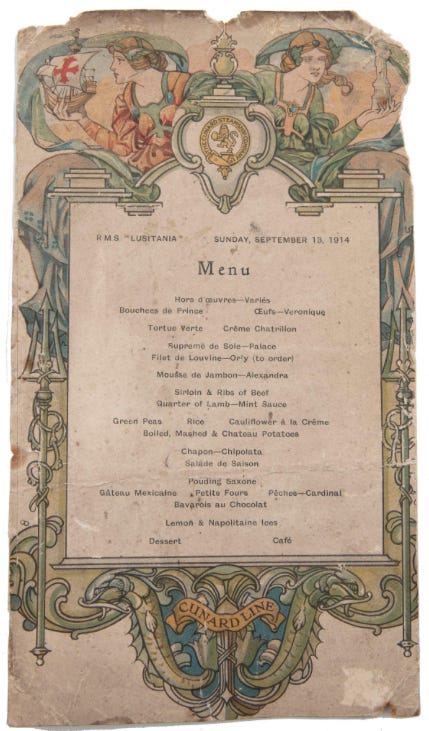Methodology & Research of a Culinary Historian
It ain't just recipes, folks.
I am greatly indebted to Lon Milo DuQuette (Poppa Lon, for some of us), for giving me a “DuQuette Bump” on Facebook and the addition of over a hundred new subscribers. However, there was some skepticism by some who complained, With a handful of notes on his dishes, do we really need a paid recipe site? I suppose that is an easy assumption to make when one sees the banner: CULINARY CROWLEY; that one is about to be met with a classic foodie blog wherein one must scroll seemingly forever through an obnoxiously drawn-out narrative of how the blogger had to amputate her own leg after a bloody attack from a Vermicious Knid, but through it all she persevered and found the true cross and strength to love again whilst interspersing the novel with process pictures of her Mac-and-Cheese (recipe for which was directly plagiarized off a Velveeta box). Of course the culprit of these diabolical meanderings is Search Engine Optimization (SEO) and the desire to have your special recipe appear in a Google search which garners more clicks and potential monetized website earnings.
It seems there was an assumption that this would be nothing but a recreation of Crowley’s known recipes, the Riz Aleister Crowley (basmati rice to be served with a curry), or possibly the most infamous and oft-misinterpreted eucharistic Cakes of Light. Yes, it is likely I will touch upon both of those at some point. However investigating Aleister Crowley from the perspective of a culinary history is a much more involved endeavor as it is far reaching beyond just those recipes he may have cooked for himself or wanted to share for posterity. It is the fact that during all his travels, he kept diaries mentioning hotels and restaurants, with whom he dined and what they dined upon. Describing an October 1930 dinner at the Muenchner Hofbrau in Leipzig with Aldous Huxley and a colleague of Albert Einstein’s, J.W.N. Sullivan, Crowley drily observed that Sullivan “was gloomy drunk on iced beer, & sick after a vast goulash, & more iced beer. Huxley improves on acquaintance." This is what fascinates me! The historian in me wants to find a 1930s menu of the Muenchner Hofbrau; what might Crowley have ordered? And Huxley?
The fact that Crowley even wrote down recipes is a novelty for an Edwardian man who wasn’t in the profession of being a cook, but is not so innovative for those who define themselves as gourmands. As an erudite bon vivant, he crossed paths with — and we can safely assume dined with — luminaries such August Rodin, W. Somerset Maugham, and William Butler Yeats. Each decade of his life was also an era of tremendous change in gastronomic and sociological circles. Do you know why the British are so crazy about curries? Crowley talked about eating Japanese food, but not in Japan, so when did Japanese restaurants begin to appear in other countries? What were his provisions for his Chogo-Ri expedition? British boarding schools have reputations for horrific cafeteria offerings and did that contribute to his sickly childhood? Sailing to America on the RMS Lusitania in October of 1914, he very well would have been presented a menu very similar to this and I may stumbled upon the very meal he ordered:
My work as a culinary historian is more than transcribing Crowley’s own words and recipes. It is delving deep into his travels to see if a menu exists from a hotel where he lodged. It is also analyzing what ingredients were available then versus what we have now, or how they have changed. I will explain how menus and dining habits have changed from the late 1800s to the middle of the twentieth-century, how Crowley’s Rabelaisian appetite for life translated into comedic culinary concoctions, and how something as modern and commonplace as sushi is now is, was once exotic and peculiar. And we know he tried it.
The research is grueling. By starting with excellent biographies by Richard Kaczynski, Phil Baker, and Tobias Churton, I am building an elaborate spreadsheet of Crowley’s life and locations. All the while, reading and underlining foodie bits in Confessions, The Equinox, and the rest of his massive oeuvre. With locations and dates, I can follow the trails of what restaurants or hotels existed in what neighborhoods or what cafés he may have frequented. I will be able to paint a gastronomic picture of a young dandy on his first Grand Tour eating Marennes oysters, or the aspiring mountain-climber surviving on tinned Danish butter and Champagne, or the plans of a potential Cefalù-based restaurant. This coming December, I will be spending a week myself in London, following his footsteps and engrossing myself in Warburg Institute for all those spicy bites which have yet be tasted.
So thank you for joining me on this journey as we feast together on the fruits of my labor and Crowley’s words.


